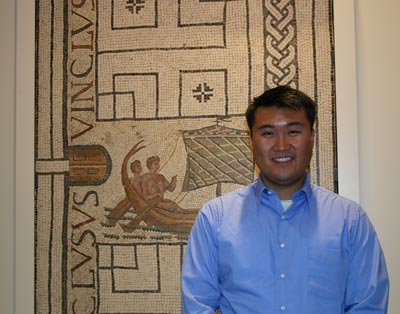Archaeologist Andrew Koh is expert at uncovering the indulgences of ancient people. The proof is in their pottery – not the designs painted thereon but in traces left behind in cups and cooking pots, dirt that Koh knows how to extract and decode. “It’s archaeology meets CSI,” he says.
For years, archaeologists have been using chemists’ tools to help reconstruct the habits and tastes of the people they study. Organic compounds lifted from excavated pottery and analyzed using gas chromatography and mass spectrometry, for example, often reveal traces of the finer things in life – wine, perfume and even traces of a meaty meal. These high-tech tools produce a “fingerprint” of each substance by separating and identifying its unique chemical components.
Researchers typically extract these organic residues months or in most cases, years after the artifacts were excavated, explains Koh. “They usually pick the pieces that are most intact or the prettiest.” Koh, a student in Penn’s Graduate Group in Art and Archaeology of the Mediterranean World, thinks researchers would get a better story if the ancient leavings were taken from as many objects as possible immediately after pulling them from the ground, before the “evidence” is removed by the washing procedures used in conservation.
As ambitious as his plan sounds, Koh pulled it off in summer 2004 at Mochlos, a village on East Crete and the site of his dissertation research. With the help of a very understanding research team led by Jeffery Soles, Gr'73, of the University of North Carolina, the support of Koh's wife and fellow archaeologist, Laura Labriola Koh, and lab equipment garnered from multiple Greek and U.S. sources, including eBay, Koh was able to extract residues at a facility just miles from the excavation site. "I forced myself into the middle of the process between the archaeologists and the conservationists."
Koh and his wife spent nearly 400 hours in the lab sampling over 300 pieces of pottery. "It was worth it," says Koh. Later, when he used the chemistry department's equipment to analyze the samples, he found that over 90 percent contained organic compounds.
Now he is using this information to piece together the perfume-making process of the Minoans, a tribe known for their stunning art and sophisticated architecture who lived at Mochlos during the Bronze Age. So far, he has been able to map the perfume-making room, identifying ingredients kept in smaller containers and the final products made in the large vat anchored next to the main wall.
Koh, who came to Penn in 1999, says that both his chemistry skills and his interest in classical archaeology came from his days as a biophysics major at the University of Illinois. “I finished all my science requirements by my junior year and was looking for something new senior year.” He immersed himself in the liberal arts, filling his schedule with courses in classics, mythology and Greek. “I absolutely loved it.” After graduating in 1996, he worked as a chemist at a pharmaceutical company while he considered applying to medical school. “In Korean-American culture,” he says, “you’re expected to get an M.D. or a J.D. A Ph.D. is a distant second.” He laughs. Still, he dared to ask himself, If I could do anything in the world, what would it be? “I already knew the answer.”



